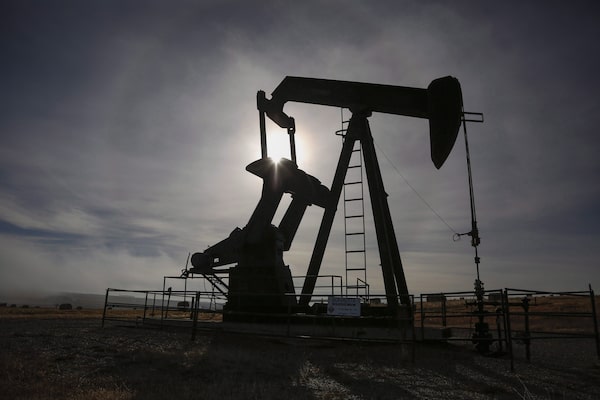
A pumpjack operates at an oil and gas installation near Cremona, Alta., in 2016. A 22-per-cent jump in U.S. benchmark oil helped to lift energy stocks on Wednesday, but as the past two months of unprecedented volatility have shown, such a gain could be erased in a dayJeff McIntosh/The Canadian Press
Three normally profitable Canadian oil companies pumped out nearly $5-billion of red ink in the first quarter of 2020, and that should send shock waves across the country.
But the most startling thing is just how unsurprising it is.
The industry has been buffeted by the collapse in demand for its products as COVID-19 pandemic restrictions have driven down economic activity, pulling oil prices to historic lows. Analysts, investors and many folks on your block have expected companies such as Husky Energy Inc., Cenovus Energy Inc. and Vermilion Energy Inc. to generate hefty net losses. The financial carnage, as they say, was “priced in.”
Much of the reported losses were the result of write-downs and impairment charges as oil price forecasts and the value of their inventories skidded. On top of that, each has shut down some production, slashed spending and gone to their lenders to secure more credit to add comfort they can ride this out.
Despite the ugly financial numbers and lingering uncertainty in energy markets, Cenovus shares jumped 14 per cent, Husky gained 12 per cent and Vermilion rose 11 per cent on Wednesday.
The big question now is how long the pain will last. April was a write-off, but now executives are speaking about recovery, though only gingerly. It’s hard to display unbridled optimism about the timing for firing up North America’s planes, trains and automobiles when the calculus that pits public-health risk against economic necessity is still being worked out.
Since the beginning of March, cash flows have dwindled and Canadian taxpayers have been called on to pay billions of dollars for credit and wage support, as well as environmental cleanup, to help the sector survive its worst period – and more government rescue money is expected.
As the old chestnut in commodity markets goes: The cure for low prices is low prices. Earlier this month, we found out that not even negative prices – a first for oil futures – cured low prices, at least not in the short term. This crisis has shown that the only cure is someone actually wanting to buy the commodity, even at a rock-bottom price, to turn it into fuel that someone wants to buy.
Oil prices rise as U.S. inventories build smaller than feared
Husky Energy slashes dividend as it reports $1.7-billion loss
Global oil price slump hitting Alberta to continue a year post pandemic, Premier Kenney says
Husky chief executive officer Rob Peabody suggested that supply and demand could be grinding into balance, with storage facilities filling up and companies cutting production. Husky has lowered its output by 80,000 barrels a day. It has also turned down the volume at its refineries rather than sell gasoline and jet fuel output into a market he calls a “train wreck.”
“So the system is working, and the market forces, as cruel as they are when you see negative prices and things like that, are doing exactly what they are supposed to do, which is to send very clear signals to people in the industry as to what actions they should be taking,” he said during a conference call to discuss his company’s first-quarter results. The company reported a net loss of $1.7-billion, and reduced its dividend by 90 per cent.
Vermilion’s net loss was $1.3-billion, due largely to impairment charges related to the sharp drop in oil price forecasts.
Alex Pourbaix, CEO of Cenovus, said China could be a guide to North American recovery. The country has relaxed restrictive measures it had in place to deal with the coronavirus contagion, and he said fuel demand has nearly recovered. Now some U.S. states and Canadian provinces are either easing physical-distancing measures or sketching out plans to kick-start their economies.
Such moves should accelerate by the summer, prompting refiners to get back to full production, he predicted. “The upstream, we’re obviously going to see a recovery here, too, but it’s probably going to be extended to some degree because of the storage builds of crude oil. It’s going to take some time to work through those,” Mr. Pourbaix said. Cenovus reported a loss of $1.8-billion, and negative cash flow of $146-million. It has cut oil sands production by 60,000 barrels a day.
A 22-per-cent jump in U.S. benchmark oil helped to lift energy stocks on Wednesday, but as the past two months of unprecedented volatility have shown, such a gain could be erased in a day. As the CEOs suggest, the sector’s recovery will be gradual. It will also take place against a backdrop of companies reporting more heavy financial losses in the coming weeks.
Your time is valuable. Have the Top Business Headlines newsletter conveniently delivered to your inbox in the morning or evening. Sign up today.
 Jeffrey Jones
Jeffrey Jones